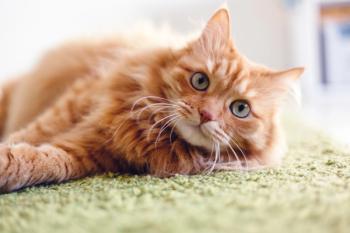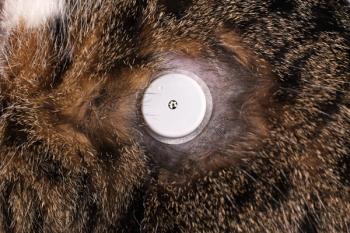
Suggested Reading: Which insulin should I choose now that my options have dwindled?
On Dec. 31, 2005, Eli Lilly discontinued four of its insulin products: Humulin L Lente insulin, Humulin U Ultralente insulin, Regular Iletin II pork insulin, and NPH Iletin II pork insulin. Our challenges are to switch patients currently receiving these products to comparable insulin preparations and to change our treatment approach in newly diagnosed diabetes mellitus cases.
On Dec. 31, 2005, Eli Lilly discontinued four of its insulin products: Humulin L Lente insulin, Humulin U Ultralente insulin, Regular Iletin II pork insulin, and NPH Iletin II pork insulin. Our challenges are to switch patients currently receiving these products to comparable insulin preparations and to change our treatment approach in newly diagnosed diabetes mellitus cases. Here are some suggested guidelines I use in my hospital.
David S. Bruyette, DVM, DACVIM (internal medicine)
Dogs
Newly diagnosed cases
1. Vetsulin (Intervet): This porcine-origin, zinc, lente insulin is intermediate-acting. Canine and porcine insulin have an identical amino acid sequence, which eliminates the theoretical complication of the dog developing anti-insulin antibodies that may adversely affect glycemic control. While the manufacturer recommends once-a-day initial dosing, I have not found this to be effective in most of our patients. I suggest an initial starting dose of 0.5 U/kg given subcutaneously twice a day. This insulin is available only at a concentration of 40 IU/ml, so make sure you provide U-40 insulin syringes to owners. Reassess the dog's clinical signs and perform a serial blood glucose curve one week after starting therapy.
2. Humulin N (Eli Lilly): This is an intermediate-acting, human-origin insulin. Suggested starting doses are 0.5 U/kg given subcutaneously twice a day. Reassess the dog's clinical signs and perform a serial blood glucose curve one week after starting therapy. The long-term availability of this product is uncertain.
A Few Words About Blood Glucose Monitoring
3. PZI insulin: This long-acting, protamine zinc, beef-pork-origin insulin has, in my experience, not been more effective in controlling clinical signs in dogs than intermediate-acting insulins. This insulin is available only at a concentration of 40 IU/ml, so make sure you provide U-40 insulin syringes to owners. I recommend an initial starting dose of 0.5 U/kg given subcutaneously twice a day. If you select PZI insulin, I recommend that you use PZI Vet (Idexx), as compounded insulins can provide inconsistent treatment results. PZI is labeled for use in cats; for additional product information see the manufacturer's Web site:
4. Insulin glargine: To date, no information on the use of glargine in diabetic dogs is available (see the discussion below regarding insulin glargine and cats).
Changing insulin
In dogs receiving Humulin L Lente insulin, I recommend switching to either Vetsulin or Humulin N. The initial dose of Vetsulin or Humulin N will remain the same as the dose used with Humulin L, but be sure to reassess the dog's clinical signs and perform a serial blood glucose curve one week after changing insulin preparations.
Cats
Newly diagnosed cases
1. Insulin glargine (Lantus—Aventis): This is a modified, recombinant, long-acting insulin analogue approved for use in people. A study presented at the American College of Veterinary Internal Medicine annual meeting in 2005 showed a high rate of remission (8/8 in remission within four months, with 6/7 still in remission at one year) in feline diabetics with the use of glargine and a low-carbohydrate, high-protein diet. The recommended starting dose is 0.5 U/kg given subcutaneously twice a day if the fasting blood glucose concentration is greater than 360 mg/dl, or 0.25 U/kg given subcutaneously twice a day if the initial fasting blood glucose concentration is less than 360 mg/dl.1-3
2. PZI insulin: As with dogs, I recommend using PZI Vet. The initial starting dose is 1 to 3 U/cat given subcutaneously once a day.4 However, in my experience, most cats will need twice-a-day administration. In my experience, remission rates are 40% to 50% within three or four months of starting treatment when this insulin is used in conjunction with a low-carbohydrate, high-protein diet.
3. Humulin N (Eli Lilly): In my experience, remission rates are 40% to 50% when this insulin is used with a low-carbohydrate, high-protein diet. Starting doses are generally 1 to 3 U/cat given subcutaneously twice a day.
4. Vetsulin (Intervet): I have seen remission rates of 40% to 50% when this insulin is used with a low-carbohydrate, high-protein diet in cats. Starting doses are generally 1 to 3 U/cat given subcutaneously twice a day.5 This product is not approved for use in cats.
Changing insulin
In cats that are receiving either Humulin L Lente or Humulin U Ultralente, I recommend switching to either PZI Vet, Vetsulin, or Humulin N. The initial starting dose remains the same as stated above for newly diagnosed patients. Reassess the cat's clinical signs and perform a serial blood glucose curve one week after changing insulin preparations. If you wish to switch to glargine, follow the dosage recommendations as outlined above under newly diagnosed cases. Note that remission rates will be much lower with glargine and a low-carbohydrate, high-protein diet in long-standing diabetic patients (cats with diabetes for more than six months) than in patients in which diabetes has been newly diagnosed.
David S. Bruyette, DVM, DACVIM (internal medicine), is a Veterinary Medicine Editorial Advisory Board member and the medical director of VCA West Los Angeles Animal Hospital in Los Angeles, Calif.
REFERENCES
1. Marshall R, Rand J. Comparison of the pharmacokinetics and pharmacodynamics of glargine, protamine zinc, and porcine lente insulin in healthy cats, in Proceedings. Aust Coll Vet Scientists Sci Week 2003.
2. Stenner VJ, Fleeman LM, Rand JS. Comparison of the pharmacodynamics and pharmacokinetics of subcutaneous glargine, protamine zinc and lente insulin preparations in healthy dogs (abst). J Vet Intern Med 2004;18:444-445.
3. Marshall RD, Rand JS. Treatment with glargine results in higher remission rates than Lente or protamine zinc insulins in newly diagnosed diabetic cats (abst). J Vet Intern Med 2005;19:425.
4. Nelson RW, Lynn RC, Wagner-Mann CC, et al. Efficacy of protamine zinc insulin for treatment of diabetes mellitus in cats. J Am Vet Med Assoc 2001;218:38-42.
5. Martin GJ, Rand JS. Pharmacology of a 40 IU/ml porcine lente insulin preparation in diabetic cats: findings during the first week and after 5 or 9 weeks of therapy. J Feline Med Surg 2001;3:23-30.
Newsletter
From exam room tips to practice management insights, get trusted veterinary news delivered straight to your inbox—subscribe to dvm360.




